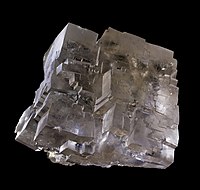
Photo from wikipedia
Abstract Transport of chloride ion into concrete can induce depassivation of reinforcement, which seriously threatens the durability of concrete subjected to marine environment. In this paper, the chloride ion transport… Click to show full abstract
Abstract Transport of chloride ion into concrete can induce depassivation of reinforcement, which seriously threatens the durability of concrete subjected to marine environment. In this paper, the chloride ion transport and binding capacity of different concrete samples located in marine atmosphere zone, splash zone, tidal zone and submerged zone for 9 and 13 months were tested. And the chloride ion profiles of one whole concrete sample exposed to all the corrosion zones for 13 months was also detected. The effect of fly ash and ground granulated blast furnace slag (GGBS) on the chloride ion transport and binding capacity of all the concrete samples were studied and the optimized replacement ratios of mineral admixtures in marine environment was proposed. The contents of Ca(OH)2 and Friedel’s salt in paste exposed to different corrosion zones were also tested by XRD and DSC-TG. Results showed chloride ion content in separate concrete samples exposed to splash zone and atmosphere zone were lower than that of the other zones, but the opposite results were observed for one whole concrete sample throughout all the corrosion zones. For separate samples, the chloride binding capacity of concrete in atmosphere zone was the lowest, and would decrease with corrosion time in marine environment. The washing effect by tidal action would lead to the loss of Ca(OH)2, abrasion of surface, and decrease of compressive strength of concrete.
Journal Title: Construction and Building Materials
Year Published: 2018
Link to full text (if available)
Share on Social Media: Sign Up to like & get
recommendations!